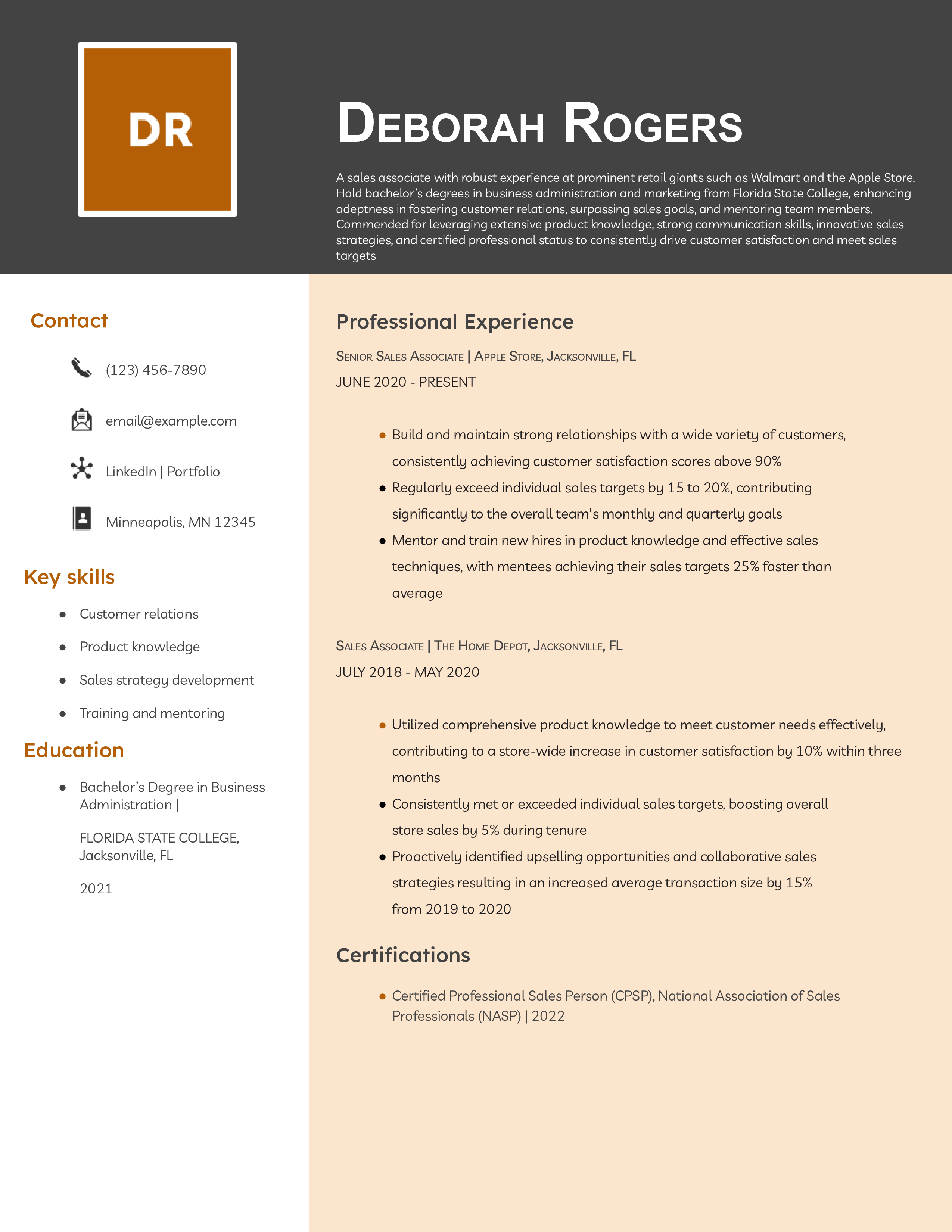General resume templates have all the basic sections and a plug-and-play format. You can fill in your information in a few minutes and have a resume ready. Although a general resume isn’t tailored to one specific organization, it should be written in a way that appeals to the core strengths and requirements of the position you’re applying for.
If you’re a job seeker looking for versatility, check out our step-by-step guide on how to make a resume to help you build effective general resume templates that work across industries.
General (Universal) Resume Templates
While this template style doesn’t work well for every job opportunity, it can be effective in specific scenarios. Ideally, every resume you submit should speak directly to that specific company’s needs, job requirements, and work values. However, this may not always be a practical option, especially if you’d like to hand out resumes at a job fair or networking event.
A general resume template design should be simple and well-organized to appeal to various industries and potential employers. Avoid anything with bold colors or intricate fonts, which can distract from your qualifications and make it harder for a hiring manager to skim.
What makes a general (universal) resume template?
When you think of what to put on a standard resume template, what comes to mind? A reverse chronological list of work experience will likely take up most of the page, along with a small skills list and a section to display your educational and professional training.
In most cases, it should include all the basic resume sections, presenting your past success with a clear focus on your unique value as a professional. The layout is often organized like this:
- Contact information
- Profile
- Professional experience
- Key skills
- Education and certifications
General resume templates are referred to as “universal” for a reason: they should apply to a wide range of industries, occupations, and experience levels. With a solid structure that includes all the essentials, your professional information is presented clearly and concisely. The 10 main components of a general resume template are:
- Simple and clean design that’s easily adaptable
- Classic color scheme for printing and photocopying
- Timeless feel that outlasts design fads and trends
- Professional fonts that are simple to read and bolded for emphasis
- Name in bold letters at the top of the page
- Traditional layout arranged in a clear hierarchy of information
- Lines or adequate white space to separate sections
- Clear headings to define each part of the resume
- Chronological format prioritizing career progression
- Simple bulleted list of key skills and proficiencies
When to pick a general (universal) resume template
A general resume template isn’t for everyone, but it can be a practical solution in certain situations. For example, imagine you’re a college student or recent graduate planning to attend a job fair on campus. Realistically, you can’t tailor every resume you distribute because you need your document ready to go. This is where a general resume can shine, highlighting your strengths and overall work experience.
Or, suppose you’re a food service worker, such as a barista or server. If you have experience, you know what hiring managers are looking for and that your skills will often transfer well from one cafe or restaurant to the next. Creating a general resume focused on your service achievements makes distributing among local establishments you’d like to work for easy.
Here are the top five reasons to choose a general resume template:
- Convey a sense of professionalism and competence
- Present a simple, straightforward resume
- Save time and effort so you can apply to more jobs in less time
- Translate industry experience from job to job
- Have your resume easily read by applicant tracking systems (ATS)
For those seeking flexibility, our guide on best resume formats can help you refine your general resume templates for different opportunities.
How to get the most out of this template
Even though general resume templates are a universal option, they should still be used with a strategy in mind. Simply listing your job duties and education won’t be enough — you must demonstrate that you’re well-qualified for the role. Next, we’ll discuss how you can maximize your potential with this template style:
- Categorize your job search efforts: Make a few versions of your general resume. For example, if you’re applying for positions in both sales and marketing, create two versions highlighting relevant skills and experiences in each field.
- Focus on your value proposition: The profile section should clearly articulate what you offer as a professional. Emphasize key strengths and qualifications that are valuable, compelling, and transferable to any employer.
- Quantify your work history: Hiring managers want to know the scope and impact of your work. Use action verbs and numbers to describe how many people you led or how much you increased sales. This illustrates the type of results employers can expect from you.
- Highlight relevant skills: If you’re using a general resume template to apply for multiple positions, proactively research the types of skills hiring managers are looking for. Study and compare job descriptions to understand better how current skills might transfer.
Versatility is key in today’s job market — remember, our comprehensive approach to general resume templates ensures you’re always ready to impress.
More Resume Templates
Looking for a different resume template? Check out this list:
| Hybrid Resume Templates and Examples | Minimalist Resume Templates and Examples |
| Resume Templates and Examples For Microsoft Word |
Frequently Asked Questions: General (Universal) Resume Templates
After you provide your contact information, start with a resume profile. This brief paragraph is two to four sentences long. It describes who you are and the unique value you can bring to potential employers. For example, suppose you have experience in hospitality, and you’re applying for positions as a front desk attendant for hotels in your area. You might write something like:
“Customer-focused hospitality professional with three years of experience in front desk operations at luxury hotels. Known for handling guest complaints with a positive attitude, receiving positive survey feedback, and maintaining a 95% guest satisfaction rating.”
The key difference between the two lies in the level of customization. General resumes are only customized to the typical requirements of the job title you’re applying for.
Alternatively, a tailored resume requires deeper research on the job opening, company, and industry. It uses specific language in the job ad throughout the document to show how an applicant aligns with that unique employer’s needs.
While a tailored resume takes more time, it usually pays off by establishing you as a well-qualified candidate. However, you can explore a broader range of opportunities with a general resume, pursuing multiple openings simultaneously.
For those who prefer a one-size-fits-all approach, our general resume templates provide a strong foundation, while our professional resume templates offer industry-specific customization.
This can be answered with both “yes” and “no.” General resumes are suitable for select circumstances. This option can save you time and energy but may lack the specificity to land an interview. While a general resume may be versatile, its impact on hiring managers may be reduced if it doesn’t adequately address the position’s needs.
A general resume template can be a good starting point for your job search. Use it to create a master copy of your most relevant experiences, skills, and training. Then, make new copies and adjust them as you apply for different opportunities.
Professional resume templates offer a structured, polished design that showcases your skills and experience. Using these templates, you can ensure that your resume is well-organized and tailored to meet the expectations of hiring managers across industries. Many sample resume templates provide general resume examples that you can adapt for your specific career path, helping you highlight achievements with quantifiable results. This approach not only saves time but also enhances your application’s visual appeal, increasing your chances of securing interviews and ultimately landing your dream job.
General resume templates offer a straightforward layout that works across many industries. They provide a plug-and-play format that lets you quickly fill in your details, making the resume creation process fast and efficient. Many websites even offer free resume templates, so you can experiment without cost. Using these templates helps ensure your resume is clear and well-organized, which is essential when you’re sending out multiple applications. They serve as a solid starting point that you can further customize to better match the job requirements.
Creative resume templates use unique design elements and layouts to help candidates in artistic or innovative fields stand out, while general resume examples focus on clarity and traditional structure suitable for a wide range of industries. Both types of sample resume templates are effective when tailored to the job description. Creative templates allow for more personalization with colors and graphics, whereas general templates emphasize straightforward, professional content.
Resume Templates offers free, HR approved resume templates to help you create a professional resume in minutes. Choose from several template options and even pre-populate a resume from your profile.

















